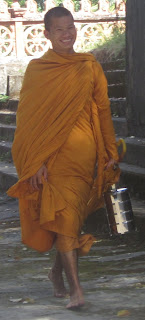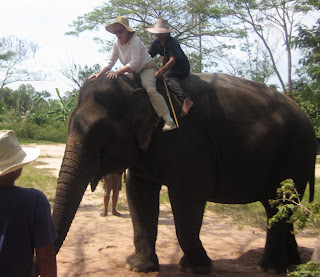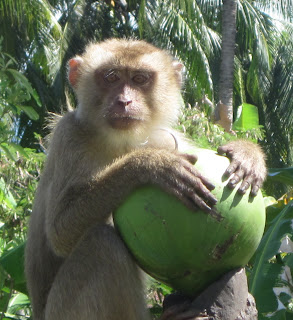The Brits were running low on water (the Japanese had cut off the water supply) for the population and to fight fires from the bombing, and ammunition was running out (it was for the much smaller number of Japanese as well); there was general chaos. Churchill sent orders to defend Singapore to the death. The chubby Japanese commander gave an ultimatum – fight or surrender. Short on food and ammunition, the British commander surrendered…tho it had been rightly impressed on the troops that being captured by the Japanese meant inhumane treatment. (Ironically, the British troops who had bent sent to Singapore earlier were so pleased as it was seen as a marvelous place to be stationed.) 60,000 British soldiers were taken prisoner!
What greeted us certainly didn’t match what was in our mind’s eye, which was in my case Singapore in the mid-40’s (tho Bill has been here more recently). We had both so looked forward to being here BUT Bill condition is now officially (blood work and x-rays) pneumonia. He is now on IV as well as oral antibiotics (started a few days for diverticulitis); mercifully the ship’s medical staff is superb and kind. We discussed our choices – such as leaving the ship and getting into a hospital; flying home ASAP was not an option as he is too sick, and we felt the MD was doing what was needed and Bill is quite comfortable on the ship. And also, more to the point, he refused to go...so here we stay.
Singapore is a truly tiny place, about 227 sq miles, on the southern tip of the Malay Peninsula. It is the most densely populated spot in the world (about 4 million people) after Monaco; about ¾ of the population is Chinese, then Malays and Indians (together about 20%). There are four official languages – Malay, Mandarin, Tamil and English. There are 6 million visitors yearly – and I think most of them were here today. Possibly because of the number of residents, there are many rules and they are seriously enforced and penalized: NO jaywalking, chewing gum, spitting, drugs (death penalty), not flushing public toilets. It’s very clean, very green and VERY HOT/HUMID. Some v spiffy modern architecture, appropriate for a place that has one of the highest average per capita incomes ($60kannually)on the planet…and is full of (we were told) overachievers. This is the biggest commercial port we have ever seen. So large that there were portable stop lights and road signs within the container area! (When I went into town, it took the shuttle bus about 20 minutes just to get to the gate.)
Bill was so disheartened that he was way too ill to do anything but esp not to revisit Raffles Hotel. (Sir Raffles claimed the area for Britain in the mid 1850’s…and it is now a member of the British Commonwealth.) So he sent me. Tho a Rolls would have been appropriate, I arrived at the Hotel by metro…an adventure in itself despite the use of English. Raffles lived up to its expectations (complete with its own museum). This side view of the veranda, hidden and presumably cooler behind palm fronds, indicates what a delightful stay could be had here.
I tried to get into the lobby but the exceedingly tall doorman, dressed like a very colorful maharaja, quickly sent me packing. Somerset Maugham was a frequent patron at the Writer’s Bar, possibly drinking its best known drink, the Singapore Sling. I stuck to a diet Coke but did have a quick lunch there…and then returned to a very sick Bill. We sat and watched the lively harbor scene as the ship prepared to bring in the gangways and hoist anchor.
The night’s sail north into the Malacca Strait brought us to the west coast of what is called Peninsular Malaysia (the rest of Malaysia is on the island of Borneo which is shared with Indonesia) and the gateway to Kuala Lumpur, the capital.
Malaysia (previously, until 1963, called Malaya), has been of interest to Europeans for about five centuries. First the Portuguese arrived closer to Singapore, in Melaka – 1511 – and overcame the local resistance (led by fighters using Solit, a v old martial art involving a uniquely shaped knife with a poisoned blade – we know this thanks to another documentary). The Dutch took over in 1641 and then the British in the early 19th C with bases in the Straits Settlements (Singapore, Melaka and Penang). Except for the Japanese during WWII, the British held on despite a revolt until independence in 1957 (in Penang I saw the bullet-ridden Rolls in which the head British official was riding when he was assassinated). There is still a king but he has ltd power; the kingship rotates among a group of nine sultans (one for each of the states which make up the country) who serve for five years. Intriquing.
Not wanting to travel far from Bill, being templed out, and not being keen on another big teeming city, I left the new cruise terminal at Port Kelang…
…and opted for a quick trip to Putrajaya…the center for the country’s government buildings and officials and about a half-hour from the capital of Kuala Lumpur. The land for this area was gifted by the sultan who owned it and thus he was given a large residence here. Note the tall, modern and expensive apartment buildings in the background.
The massive government buildings – at least a hundred of them – are situated around a huge manmade lake…on which we sailed (on a smallish luxury craft…a real toilet with TP and soap). The bridges are modeled after world famous ones, this one from Paris.
Not surprisingly, manyof the buildings had a mosque-like quality.
The buildings are glorious…I took many photos but they just look like really spiffy modern ones that one could find anywhere (but are surprising here). Note the street lights which are shaped like cobras (this land was a palm tree plantation and cobras were used to keep the rats/vermin in check).
Of course, there was an enormous mosque…a new one which I didn’t go into (infidels can see some of it but not all) as it wasn’t of historic interest and also I did NOT in this heat (and given that I am totally against the covering up of women) want to put on a robe complete with hood.
There were fellows who dealt promptly and with no smiles with any woman whose foot trod over the line…kind of like the bears waiting for Christopher Robin to step on a crack. I watched as he pounced on several women and then his gaze fell on me…he was poised to shoo me away.
When I went searching a bathroom, I smelled something really awful, like vomit, and then saw this ad and knew durian fruit was being served somewhere nearby.
Leaving and returning to the ship (free wifi at the dock – tho the temp was grueling) we saw living conditions nothing like what we saw on our tour; here was what looked like abject poverty in buildings that were windowless and crumbling and there appeared to be no electricity…the perfect venue for a zombie flick. However, things are changing – rapidly. Most of this is attributable to one forward looking PM who realized Malaysia could not rely on just its traditional revenue sources of rubber and tin and palm oil, but needed to modernize and expand. This was only a few decades ago but Malaysia certainly has caught on…with a vengeance, as exemplified in Putrajaya and the metropolis of Kuala Lumpur. Manufacturing (esp of high tech electronic goods), petrochemicals and tourism have boomed. Our guide promoted a new program, My Second Home, that has been launched to encourage vacation homes among foreigners (unlike Thailand, foreigners are allowed, in fact wooed, to purchase land here).
The ship then moved a bit north up the coast to Penang for another day ashore in the “Pearl of the Orient” (aka the island of betel nuts…tho the chewing of the leaves has fallen out of fashion and is used by only some of the elderly). Penang is mostly an island (a chunk of it is on the mainland and connected by an 8-mile bridge, almost visible in the photo of the very new if mostly empty terminal building).
The geography of Penang (as well as Melaka and Singapore) – on the tea and opium sea route between India and China – really piqued British interest; the remnants of Fort Cornwallis are still here in the capital of George Town (named after George III) with a cannon that the initial Britisher (Captain Light) used in a unique way; to encourage the local workforce, he filled the cannon with silver coins and fired it…to find the silver, they cleared the area of jungle. Some of the colonial buildings remain, and are in current use.
After a 94th birthday breakfast with Bill (he loved the Raffles mug), I went out to quickly see a little of Penang. There is no Chinatown here…the whole city is dominated by the Chinese. There are five main clans here and my short tour visited the Khoo Kongsi, the meeting houses and ancestral temples of the Khoo family. Incredibly ornate and elaborate Chinese décor and furnishings (we are talking beyond rococo) were on display but other than learning that clans don’t get along well (think of the Tong wars) and are not welcome at each other’s clan houses, our tired guide was not among our better ones. Some of the clan members (the older ones who don’t like more modern accommodations) continue to live in stilt houses on the water, of which I could not get a photo.
Parts of the relatively recent film with Jodie Foster as Anna (King and I stuff but not a musical) was filmed here (in this clan house); Thailand wouldn’t let it be filmed there – and it is illegal to see either film version there (inappropriate familiarity with the royal family). (Clearly the photo taken at night was NOT one of mine but it shows the façade of the meeting house without any tourists cluttering the scene.)
The interior shots are mine...but don't do justice to the beauty inside (and on outside walls).
We passed a Buddhist temple in full swing for a celebration (note the oversized jost sticks) before going to see a Chinese mansion built at the end of the 1800’s. More incredibly ornate and elaborate Chinese décor, much of the furniture being superb examples of black lacquer with mother of pearl inlay (including the opium bed on the first floor).

My taxi driver, Kamal, said there was more to see if I was willing. But of course! Who would turn down a chance to have a python wrapped around one? Note the viper acting as a hat band…that final sartorial touch. The python was quite lively, fairly heavy, cool to the touch (which I was not), and felt surprisingly squishy. All in all, less terrifying than riding the Indian elephant.
The ship then sailed due west for several days in the Indian Ocean (the smallest of the three oceans) toward Sri Lanka. (We have learned – or relearned – that oceans are large bodies of water surrounded by continents, as opposed to seas which are also large but surrounded by countries.) This route means that we are seeing nothing of the countries to the north of Malaysia on the other side of Thailand: Myanmar (Burma) or abutting India, Bangladesh. In the meantime, Bill is still on IV meds but is coming around…his breathing is not sounding so much like porridge on a low boil. He is very weak and tires easily.
We had been given a written notice about the (slim) chance of piracy in the area we are going to be sailing in for the next two weeks until we arrive in Sharm El Sheikh, Egypt. Not only will there be specially trained folks from the Royal Navy coming on board, but the verandah deck where I do my miles will be closed from sunset to sunrise and the ship will make a number of changes to diminish its visibility: passengers will be required to keep window and balcony draperies closed when cabin lights are on. We also had a drill for what to do in case there is trouble; for those of us with windows and balconies, we are to move into the corridor and stay put, and not sit/stand in front of our cabin doors (lest we get shot). WOW!





































































